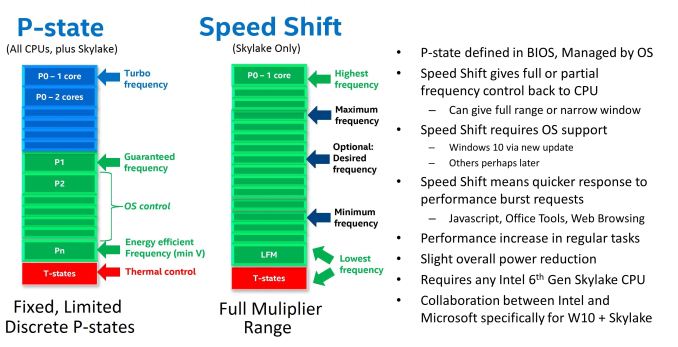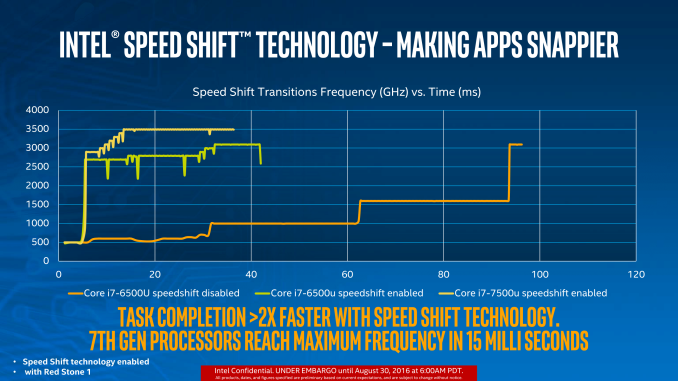The Intel Core i3-7350K (60W) Review: Almost a Core i7-2600K
by Ian Cutress on February 3, 2017 8:00 AM EST7th Generation New Features
One of the big questions regarding the launch of Intel’s 7th Generation of CPUs was around what extra features the new platform brings, especially if there isn’t any clock-for-clock performance improvement. As with our other Kaby Lake reviews, here we explain the main two: Speed Shift v2 and Optane Memory support.
Speed Shift v2
For the Intel’s 6th Generation of processors, Skylake, they introduced Speed Shift (v1). This was a feature that, at a high level, gave control of the voltage/frequency curve from the operating system to the processor. Using a series of internal metrics, such as instruction analysis and frequency, the CPU would automatically adjust the voltage and frequency of the processor as required. This afforded two major benefits: one, with the CPU in control it has access to many more points on the curve compared to the OS which is limited to specific P-states on the processor.
The second benefit is the speed of transition. A processor that can ramp up to a high frequency quickly and then drop down as needed can get through instructions quicker but also save power. Imagine driving a car, and having to wait 60 seconds to change a gear – it’s that sort of analogy.
What Speed Shift v2 does in the Kaby Lake family, compared to v1 in Skylake, is manage those transitions to higher frequency faster. Before Speed Shift, transitions from idle to peak turbo were on the order of 100 milliseconds, and Speed Shift v1 took that to 30 milliseconds (with a good base established within 15). Speed Shift v2 means that peak performance from idle now happens in 10-15 milliseconds total. This means that interactions with the OS, such as touch, or actions that rely on low latency, can occur within a couple of frames on a 60 Hz display.
The benefit of Speed Shift lies a lot in touch devices, which perhaps doesn’t affect the desktop Kaby Lake processors in this review, but also in web interactions. A lot of web work is stop and start, such as scrolling or javascript functions.
There is one caveat however – Speed Shift currently only works in Windows 10. It requires a driver which is automatically in the OS (v2 doesn’t need a new driver, it’s more a hardware update), but this limitation does mean that Linux and macOS do not benefit from it. I would be hard pressed to not imagine that Apple and Intel were not working on a macOS driver, but as yet we have not had confirmation that one exists.
Optane Memory Support
The latest memory technology to hit prime time is Intel and Micron’s 3D XPoint. This is a non-volatile form of data storage that is bit addressable and can be used as DRAM or storage. Despite being at least a decade in the making, and being formally announced in 2014, it is still yet to show up commercially as it is still being developed. Intel plans to create 3D XPoint DRAM that is slightly slower than normal DRAM but both denser (more of it) and non-volatile (keeps the data after power loss, saves power altogether), as well as 3D XPoint Storage that is faster than standard NAND flash, and more configurable. It the scheme of things, we expect the storage based products to hit the market first.
Intel, as far as we can tell, is set to release two main classes of product: Optane DRAM to be pin-compatible with DDR4 and require Optane DRAM enabled processors, and Optane SSDs which should work with any PCIe storage interface. ‘Optane Memory’ however, is something a little different. Based on pre-briefings, Optane Memory is certainly not Optane SSD we were told, but rather a storage cache for mechanical hard-drives. We’ve had this before with NAND flash drives, using Intel’s Rapid Storage Technology, and it seems that Kaby Lake and 200-series chipsets will support a new version of RST for PCIe based storage. But because this is caching drive, such as the 16GB Optane Memory drives in Lenovo’s upcoming notebooks, and not Optane SSD, might lead us to believe that ‘Optane Memory’ drives are not designed to be directly user addressable.
All that being said, Intel has stated that Optane Memory standalone drives should hit the market nearer Q3 for general consumer use, which is more in-line with what we might expect to see with Optane SSDs in the enterprise space.













186 Comments
View All Comments
cknobman - Friday, February 3, 2017 - link
I definitely think they should have at least included those results.fanofanand - Friday, February 3, 2017 - link
Some people purchase a "K" processor for the binning, not to overclock it.JackNSally - Friday, February 3, 2017 - link
Ok. So exclude those that buy it to overclock?fanofanand - Sunday, February 5, 2017 - link
I was responding to the comment saying the only reason to get a k was to overclock.WithoutWeakness - Friday, February 3, 2017 - link
Absolutely should have included overclocking. Sandy Bridge chips had very conservative stock clocks and great overclocking potential. At the time you were almost guaranteed 4.4GHz-4.7GHz on air and and there were lucky users reaching 4.8-5GHz (and more under water). My 2600K has been running stable at 4.6GHz (a 35% overclock) for six years now at 1.35v. Those single-threaded charts would look much different if you included overclocks and the multi-threaded charts would seriously widen the gap.I'm glad Intel has opened the gates for overclocking i3's but this review really just shows how small Intel's gains have been in the last six years. I'm hoping Ryzen brings some serious performance to the table (especially at the high end) and lights a fire under Intel's asses. Better iGPUs and lower power consumption are great for laptops and and basic users's needs but there has been no innovation in the HEDT market for many years unless you're willing to shell out $1700 for the 10-core Extreme Edition.
CaedenV - Friday, February 3, 2017 - link
Yep! Sandy Bridge was/is good tech!I got the non-K i7 Sandy Bridge, and even that overclocked easy to 4.2GHz. It was an artificial limit, but I didn't need to spend the $50 premium to get a potential 3-500MHz out of it. Been humming along for 6 years now and hasn't missed a beat!
At this rate I will probably be 'upgrading' my game rig to a tiny little i3, and recycling my i7 as a home server for storage and VMs.
eldakka - Sunday, February 5, 2017 - link
"(and more under water)"Shocking.
dragosmp - Friday, February 3, 2017 - link
Agreed, Ian might have posted them. Still, read between the lines: there is a statement the 2600K does 4.8-5GHz. At 20% higher clock speed, the 2600K destroys the OCed i3 7350K, no contest. It may consume 4x the power, but dunno, do you care when the GPU consumes 5x more anyway?CaedenV - Friday, February 3, 2017 - link
Ya, not too useful on the gaming charts as even the non-K chips kept up with the GPUs just fine. But getting to see what it does for productivity tasks would be interesting.Actually, stock vs OC i3, i5, i7, and i7 Sandy would be very interesting to me.
dave_the_nerd - Friday, February 3, 2017 - link
Too much individual variation. Non-overclocked performance is the guarantee. Everything else is up to chance in the silicon lottery.Also potential for abuse: say, the manufacturer sends reviewers some golden sample that hits 5.1GHz on air. Hah! GPU makers used to pull stunts like that.